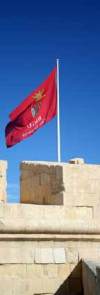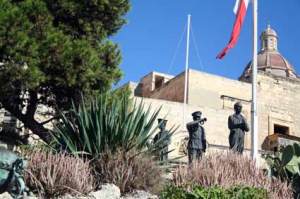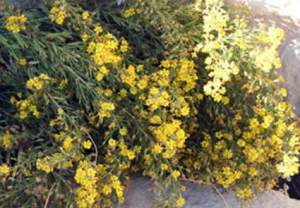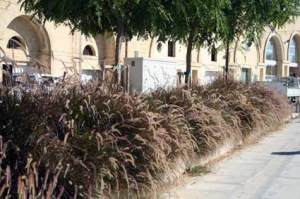
Thursday November 7th, 2013.
The Caper at Couvre Porte
Alfred E. Baldacchino

Citta Vittoriosa flag
The Birgu Local Council deserves warm congratulations for the way they organised the Birgu Fest especially the candlelit night which showed the splendour of the city: the overpowering majestic bastions, the Maltese workmanship, the architecture, the intricate sculptures, the winding streets, the renovated old buildings, and the growing public awareness of such a historical heritage. Unfortunately this cannot be said for the way the Birgu environs are being landscaped.

Couvre Porte Gate
I entered through Couvre Porte, the magnificent covered gateway, admiring the surroundings. I crossed the bridge over the ditch, still in total darkness as to its future, at least from a public point of view. I wonder why no public consultations were ever held on such projects. Perhaps the present Minister would consider this before the works are done and public money spent and not follow in the footsteps of his predecessor.
Once through the main entrance of Couvre Porte, I climbed the 10 cm or so high steps leading to the top of the bastions. I could almost relive the moments of such a historical architectural heritage left to us by the Knights of St. John.
There, on the highest part of the bastions something caught my eye: it was a caper (kappara) growing on one of the cordons, so soon on the freshly restored bastions, with defiance and a sense of victory. In the dim light, I could see the silhouettes of other indigenous plants which had also set foot on the fortifications: indigenous species which colonised these islands before man set foot on them.

The caper on the bastions
The indigenous plants on the bastions echoed Rużar Briffa’s Jum ir-Rebħ “Jien Maltija! Miskin min ikasbarni, miskin min jidħak bija” (I am Maltese! Pity the one who disgraces me, pity the one who mocks me”).
As I looked towards the Vittoriosa water front, the historic bastion rose as a background to a number of recently imported alien, toxic and some invasive trees. The never conquered Citta Vittoriosa, lied at the mercy of these introduced foreign species, some also invasive, politically approved and publicly funded. How could one accept the fact that there at the foot of the bastions exotic species had taken over the beds of the indigenous Maltese species, through the political apathy still accepting foreign colours to the indigenous splendour.
I slowly descended the steps, seemingly so much higher now, and mingled with the crowds till I found my way in front of the St. Lawrence Parish Church. Towering in front of the Church on my left was the Għolja talĦelsien monument, a reminder of the last foreign power which had a foot in Malta. But even in the semidarkness I could see the monument invaded with more than half a dozen exotic species, two or three invasive. Two palm trees on the monument seemed to have succumbed to the Red Palm Weevil, an introduced alien invasive species. On my right along the waterfront leading to dock 1, I could see other exotic species, some invasive, introduced from around the world, including the now ubiquitous fountain grass. Could it be possible that the exit of the foreign powers opened the doors to the exotic alien flora and fauna to set foot on the Islands even growing on the very monument itself?

Three exotic alien species surround the fanfare of the departure of the last foreign soldier.
Landscapers equipped with a can of chemicals will no doubt be sent by their political master, the Ministry of Infrastructure and Transport, to spray the indigenous caper and allies to oblivion, something in which I must admit, they are very good at. But these are wild species and do not fatten anybody’s pockets. I am sure that the indigenous species will rise again, and again, and again in protest with the same determination, as one or two have already done at the newly renovated Mdina bastions, made more to resemble Windsor Castle rising out of an expanse of turf, so artificial and unnatural to a Mediterranean fortification rising out of garigue vegetation. As long as the people and the EU pay, who cares? Who would be that Minister who, during whose tenure, approved the introduction of the most exotic alien species, not excluding invasives, in the Maltese Islands at the expense of local indigenous species, in the name of landscaping? The wisdom of some politicians knows no bounds despite national and international obligations, and should I add electoral promises!

The Golden Samphire on the restored Vittoriosa bastions. It can easily replace the introduced exotic invasive species of Fountain Grass occupying the flower beds on the waterfront.
I walked heavily to where my car was parked close to St. Helena Bastions another jewel of the Knights of St. John. Another gem of a historical heritage so conspicuous by its neglected and abandoned state. If only the funds coming from the European Union and public funds lavishly spent on the importation, advice, planting and profits made on the exotic trees, went to the restoration of such other gem at Bormla (Cospicua) they would have been much better spent.

The now ubiquitous introduced alien invasvie Fountain Grass, in the shadow of alien trees, competing and taking over from indigenous flora.
It was a relief to drive back home. But not before driving through a breach in the Cottonera bastion lines leading from San Ġwann t’Għuxa to Għajn Dwieli. The mismanagement, lack of planning and financial driving force in landscaping with its negative social, historical and ecological impact had ruined the enjoyable candlelit evening at the historical city of Birgu. The good thing about it was that the candlelit environment had hidden the look of disappointment on my face: the lack of considerations for local biodiversity makes me feel ashamed that I am Maltese, when this is appreciated more by the foreigners than by the local politicians. When money grows on trees and it talks, there is nobody ready to listen.
alfredbaldacchino.wordpress.com
In the first instance, Aloe vera, which is one of the species in the photo, presumably referred to as alien, is an archaeophyte, just like the olive and the carob, among other species that occur in the Maltese Islands. The carob, olive, the Great Reed and other such archaeophytes were brought to the Maltese Islands in antiquity, just like the Prickly Pear was, albeit centuries later, during the Columbian Exchange. We are merely being selective in giving labels to plants that were ultimately introduced, at some time or other. Just like the carob, the prickly pear (like it or not) forms part of the (Thermo-) Mediterranean landscape.
I say, God forbid landscapers stuck to indigenous species in urban areas (unless there is a real danger of invasion into natural habitats, as was the case of the Fountain Grass in some locations). There are so many exotic tree species that could be used to embellish urban spaces, and that would enhance such places aesthetically, that it would be a pity to use solely our limited suite of indigenous ones – it is taking a somewhat narrow, almost talibanistic, view to conservation.
Native vegetation should be use to ecologically restore areas that, over time, became degraded. With the phenomenon of widespread agricultural land abandonment, local authorities would do well to embark on a national programme to restore our woodlands, including that typical of the Mediterranean, the maquis.
You do indeed take a very simplistic view to indigenous flora versus introduced aliens species. You mention two species on the Għolja tal-Ħelsien saying they are achaeophytes, but you conveniently omit the other four or five. And you seem to have no qualms that these were planted on such a monument, ignoring the other 1000+ indigenous species, many of which could have graced and better adorned such momument. This I know is a matter of taste, but I am sorry to say that I do not agree with you.
I never said that landscapers are to stick soley to indgenous species for landscaping: you are quoting me out of context. I know that this is what landscapers say. As you may well know, all past governemnt nurseries which once contributed to the propagation of indigenous species, today do not contribute any more to such propagation, either for the sake of landscaping or for their conservation, as the country is obliged to do under the various international obligations, including those of the EU. The nurseries which provide trees for landscaping in the Maltese Islands are today all situated in Sicily. You might be aware that the trees used to landscape the Cottonoera waterfront, all imported from Italy, cost the Maltese taxpayer €30,000 as divilged in a recent parliamentry question. What amount of money is going towards the propagtion of indegenous species to ensure their protection considering the ever increasing pressure they are under, even from imported alien species?
Your comment that I am “..taking a somewhat narrow, almost tallibanistic view to conservation” brought a smile to my face, as I am sure it will bring a smile to your face if I say that your stand on the introduction of exotic alien species is taking a somewhat narow, almost mercenary view to landscaping. I have also heard your comment form landscapers who are unpurterbed by the damage that is being done to local biodiversity. But again you completely bypass the negative impact of the introduction of aliens speices when these could easily be propagated here, obviously cutting down on profits and export of local currency, which is the main driving force in landscaping in Malta. And the externatilites of this is being paid by society and the environment through the introduction of aliens invasive speics. I am sure that you have heard about the Red Palm Weevil, the Geranium Bronze Butterfly, the Mulbery Longhorn Beetle, etc., etc.. all introduced through the use of the importation of flora, mainly for landscaping. Do you think that this justifies the way landscaping is being ‘managed’ in Malta?
I am afraid that your views on landscaping are very different form mine and do not address the issue from a holistic point of view. My aim is the conservation, protection and public awareness of local biodiversity. Your comment that it would be a pity to use solely our limited suite of indigenous ones is unfortunately in line with what local landscapers also say to justify the importation of exotic species simply from a commercial point of view and lacking any conservation ideals. And it also endorses my comment in my article: going for foreign colours instead of indigenous splendour.
i totally agree with your comments. There is so much to be done at the three cities . We the Sengleans have been asking the governments to remove three scrapped dockyard cranes from our faces at bastion street. they have laid them there not being used for 14 years and still nothing happens . Mepa is FAKE. Progress is lacking. They are more interested in top stories buildings which also is a big eyesore . Once they get the vote then that’s it . Voting for european candidates is near .
Well said Alfred and Victor ! Making Easy PlaNing Activities is only there for commercial activities and its artificial/mercenary environment. God only knows what’s in store for Xemxija and Il-Wied tax-Xamgha (Mistra Valley)
n.b. PlaNing= levelling, removing all obstacles!
Dear Alfred what keeps us from putting a programm on tv giving il- Poplu the possibility to voice himself on many local environmental obscenities ?Only then governments will be exposed to their failings . Mistra valley will become the haven for powerful people in parlament besides causing more traffic around the area . When one looks at the main entrance street in Zebbug Malta he only sees a cemetry like thing where the main attraction have become the lightposts instead of trees . If one compares two photos of same street as it was and as it is now one becomes astounded . And all this in the name of so called progress . Unless il- Poplu will not voice himself this tragedy will persist .
Victor, I fully agree with you. But it is up to each and every one of the people to make one voice heard. For the last seven years I have been expressing myself, on my own, in favour of biodiversity trying to raise an awarenss, and criticising in strong terms the obscenities that are going on in this country of ours, irrispective from which side. I have been writing and also taking part in radio and TV programmes, whenever I am invited that is. What keeps everyone from doing likewise? And I have also gathered some nice adjectives from politicians and politicaly oriented persons, if you know what I mean. But this is a further stimulus for me to go on especially when I realise that silence is the weapon of politicans, Unfortunately I cannot force anyone or speak up one’s mind and be heard. If everybody wants to take the drop, I am trying my damnest not to.